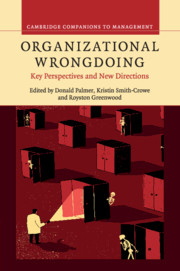Book contents
- Frontmatter
- Contents
- List of figures
- List of tables
- List of contributors
- Foreword
- 1 The imbalances and limitations of theory and research on organizational wrongdoing
- 2 On taking the theoretical substance of outcomes seriously: a meta-conversation
- 3 Wrong paths to right: defining morality with or without a clear red line
- 4 From market enablers to market participants: redefining organizational and political-legal arrangements and opportunities for financial wrongdoing,1930s–2000
- 5 Wrongdoing and market development: an examination of the distinct roles of trust and distrust
- 6 Bad apples, bad barrels and bad cellars: a “boundaries” perspective on professional misconduct
- 7 S/he blinded me with science: the sociology of scientific misconduct
- 8 Social networks and organizational wrongdoing in context
- 9 Falling stars: celebrity, infamy, and the fall from (and return to) grace
- 10 Compensation and employee misconduct: the inseparability of productive and counterproductive behavior in firms
- 11 Beware of organizational saints: how a moral self-concept may foster immoral behavior
- 12 “Is it me? Or is it me?” The role of coactivated multiple identities and identifications in promoting or discouraging workplace crimes
- 13 Consequences of organizational misconduct: too much and too little punishment
- 14 Who bears the brunt? A review and research agenda for the consequences of organizational wrongdoing for individuals
- 15 Organizational wrongdoing and media bias
- 16 Ethical learning: releasing the moral unicorn
- Index
- References
15 - Organizational wrongdoing and media bias
Published online by Cambridge University Press: 05 July 2016
- Frontmatter
- Contents
- List of figures
- List of tables
- List of contributors
- Foreword
- 1 The imbalances and limitations of theory and research on organizational wrongdoing
- 2 On taking the theoretical substance of outcomes seriously: a meta-conversation
- 3 Wrong paths to right: defining morality with or without a clear red line
- 4 From market enablers to market participants: redefining organizational and political-legal arrangements and opportunities for financial wrongdoing,1930s–2000
- 5 Wrongdoing and market development: an examination of the distinct roles of trust and distrust
- 6 Bad apples, bad barrels and bad cellars: a “boundaries” perspective on professional misconduct
- 7 S/he blinded me with science: the sociology of scientific misconduct
- 8 Social networks and organizational wrongdoing in context
- 9 Falling stars: celebrity, infamy, and the fall from (and return to) grace
- 10 Compensation and employee misconduct: the inseparability of productive and counterproductive behavior in firms
- 11 Beware of organizational saints: how a moral self-concept may foster immoral behavior
- 12 “Is it me? Or is it me?” The role of coactivated multiple identities and identifications in promoting or discouraging workplace crimes
- 13 Consequences of organizational misconduct: too much and too little punishment
- 14 Who bears the brunt? A review and research agenda for the consequences of organizational wrongdoing for individuals
- 15 Organizational wrongdoing and media bias
- 16 Ethical learning: releasing the moral unicorn
- Index
- References
Summary
Introduction
A social constructivist view of wrongdoing conceives organizational transgressions as the result of a two-way interaction between organizations and observers (Becker 1963; Greve, Palmer, and Pozner 2010). This view suggests that judgment determines whether organizational actors have crossed a fuzzy line separating right from wrong. This requires collecting, interpreting, and evaluating information that is sometimes ambiguous and conflicting, from many sources with varying credibility. Observers include governmental bodies, the state, professional associations, and organizational managers acting as authoritative social control agents that have formal authority to monitor individual and organizational behavior, evaluate transgressions, and impose sanctions when appropriate. Observers may also be stakeholders and members of the public who have little formal authority, yet have a direct or indirect interest in an organization's activities. These include interest groups, rival organizations, customers, suppliers, and informed private citizens. These groups form an expansive audience that consumes information about transgressions, and formally and informally influences opinions, decisions, and even the rules of social control agents who depend on the public for legitimacy. A constructivist view of wrongdoing thus recognizes that major organizational transgressions involve complex webs of public and private orderings.
Media organizations help coalesce these groups by serving as information intermediaries, collecting, interpreting, and distributing information among transgressors, social control agents, and other publics (Deephouse and Heugens 2008). Investigative media unearth concealed and oblique activities, reframe activities that challenge benign interpretations, and publicly broadcast these framings across temporal and spatial boundaries. Bureaucratic routines can filter organizational deviance and shield transgressions from public view and even use bureaucratic definitions to frame behaviors as legitimate (Becker 1963; Greve et al. 2010; Wheeler, Weisburd, and Bode 1982). Even when transgressions become public, fear of retribution and contamination serve as strong incentives to avoid correcting them (Adut 2005). An important role for investigative media organizations is to penetrate these filters and framings and to find and publicize controversial behaviors. In this way, private and public orderings become commingled, contested, and reformulated if necessary.
Nowhere is the role of the media more apparent than when organizational transgressions become full-blown public scandals. Scandals are triggered when suspect behaviors are exposed, framed, and broadcast in a way that causes general moral outrage (Adut 2005).
- Type
- Chapter
- Information
- Organizational WrongdoingKey Perspectives and New Directions, pp. 435 - 473Publisher: Cambridge University PressPrint publication year: 2016
References
- 13
- Cited by



